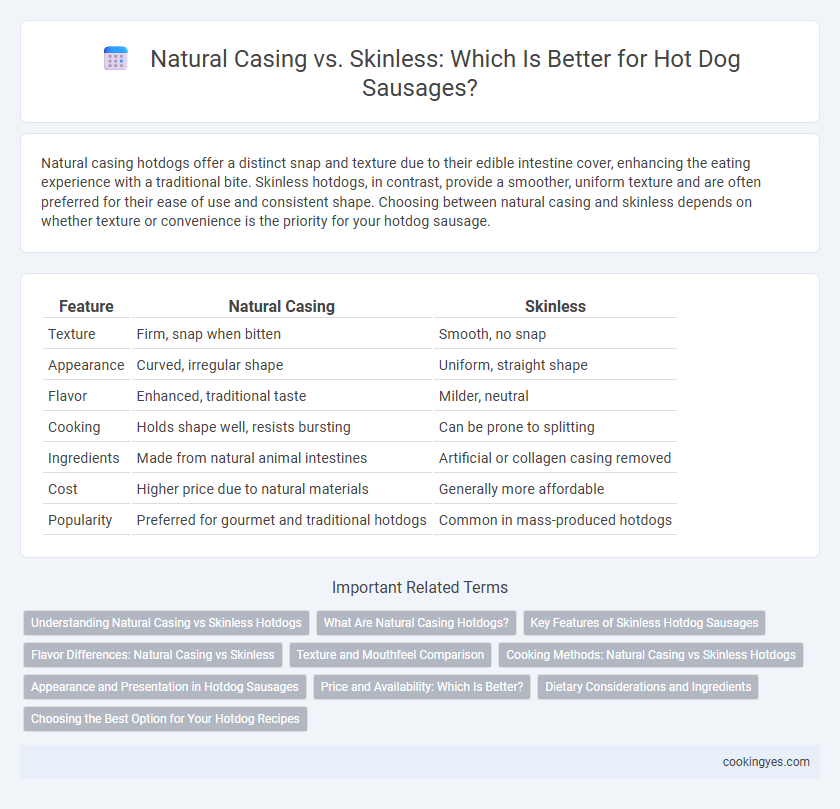Natural casing hotdogs offer a distinct snap and texture due to their edible intestine cover, enhancing the eating experience with a traditional bite. Skinless hotdogs, in contrast, provide a smoother, uniform texture and are often preferred for their ease of use and consistent shape. Choosing between natural casing and skinless depends on whether texture or convenience is the priority for your hotdog sausage.
Table of Comparison
| Feature | Natural Casing | Skinless |
|---|---|---|
| Texture | Firm, snap when bitten | Smooth, no snap |
| Appearance | Curved, irregular shape | Uniform, straight shape |
| Flavor | Enhanced, traditional taste | Milder, neutral |
| Cooking | Holds shape well, resists bursting | Can be prone to splitting |
| Ingredients | Made from natural animal intestines | Artificial or collagen casing removed |
| Cost | Higher price due to natural materials | Generally more affordable |
| Popularity | Preferred for gourmet and traditional hotdogs | Common in mass-produced hotdogs |
Understanding Natural Casing vs Skinless Hotdogs
Natural casing hotdogs are made from cleaned animal intestines, offering a distinct snap and enhanced flavor due to their porous texture, which allows smoke and seasoning to penetrate during cooking. Skinless hotdogs, on the other hand, use a collagen or cellulose casing that is removed after cooking, resulting in a smoother texture and uniform appearance preferred for mass production. Choosing between natural casing and skinless hotdogs depends on the desired eating experience, with natural casings favored for artisanal quality and skinless for convenience and consistent texture.
What Are Natural Casing Hotdogs?
Natural casing hotdogs are made using the cleaned intestines of animals, typically hogs, sheep, or cattle, which provide a traditional snap and a distinctive chewy texture when bitten. This casing is edible and allows for better smoke penetration, enhancing the flavor profile compared to skinless hotdogs, which lack this natural outer layer and tend to have a uniform, softer chew. Natural casing hotdogs are favored by purists and gourmet sausage makers for their authentic mouthfeel and superior taste experience.
Key Features of Skinless Hotdog Sausages
Skinless hotdog sausages feature a uniform texture and consistent shape, enhancing the cooking experience by preventing casing splits or peeling. They offer ease of preparation and versatility, making them ideal for grilling, boiling, or frying without worrying about casing integrity. The absence of natural or artificial casings also appeals to consumers seeking a smoother bite and simpler ingredient profiles.
Flavor Differences: Natural Casing vs Skinless
Natural casing hotdogs offer a distinctive snap and enhanced juiciness due to the natural animal intestine, enriching the overall flavor profile with a subtle earthy and savory complexity. Skinless hotdogs provide a smoother, more consistent texture but lack the characteristic bite and slightly smoky notes imparted by natural casings. The flavor difference is especially noticeable when grilling, as natural casing sausages develop a crisp exterior that seals in moisture and intensifies taste.
Texture and Mouthfeel Comparison
Natural casing hotdogs offer a distinctive snap and slightly chewy texture due to the collagen or animal intestine wrap, enhancing mouthfeel with a satisfying bite. Skinless hotdogs provide a smoother, softer texture that melts more uniformly in the mouth, lacking the crisp resistance of natural casings. Texture preference depends on the desire for a traditional snap versus a tender, easy-to-eat sausage experience.
Cooking Methods: Natural Casing vs Skinless Hotdogs
Natural casing hotdogs offer a distinct snap and crispness when grilled or pan-fried due to their edible intestine wrapping, enhancing the texture and flavor profile. Skinless hotdogs, often preferred for boiling or microwaving, provide a smooth, uniform bite but lack the characteristic snap of natural casings. Grilling natural casing hotdogs requires careful attention to avoid bursting, while skinless varieties are more forgiving and less prone to splitting during cooking.
Appearance and Presentation in Hotdog Sausages
Natural casing hotdog sausages offer a distinct snap and irregular shape that enhances visual appeal and signals authenticity to consumers, while skinless hotdogs present a uniform, smooth exterior ideal for mass production and consistent presentations. The natural casing's translucence allows specks of seasoning and meat texture to show through, adding to the artisanal aesthetic, whereas skinless versions provide a clean, polished look favored in fast-food settings. Presentation in restaurants often favors natural casings for gourmet menus due to their rustic charm, whereas skinless sausages are preferred for streamlined plating and ease of peeling.
Price and Availability: Which Is Better?
Natural casing hotdogs typically cost more due to the higher quality and traditional processing involved, making them less widely available in standard supermarkets compared to skinless varieties. Skinless hotdogs offer greater affordability and broader availability, favored by mass producers and retailers for consistent supply and cost efficiency. Consumers prioritizing budget and easy access often choose skinless options, while those seeking premium texture and flavor might opt for natural casing despite the higher price and limited availability.
Dietary Considerations and Ingredients
Natural casing hotdogs are typically made from animal intestines, offering a chewier texture and often containing fewer additives and preservatives, making them a preferred choice for those seeking more natural ingredients. Skinless hotdogs usually include synthetic casings and may have additional fillers, binders, and preservatives, which can be a concern for individuals with dietary restrictions or sensitivities. Consumers focusing on clean eating or allergen-free options should carefully examine ingredient labels to determine suitability based on casing type and ingredient composition.
Choosing the Best Option for Your Hotdog Recipes
Choosing between natural casing and skinless hotdog sausages depends on your desired texture and flavor profile. Natural casing, made from animal intestines, provides a satisfying snap and enhances juiciness, ideal for traditional, gourmet recipes. Skinless sausages offer a smoother bite and are easier to produce in uniform shapes, making them perfect for family meals and mass production.
Natural casing vs Skinless for hotdog sausage Infographic

 cookingyes.com
cookingyes.com